Exploring the Essentials of Hoop Tent Greenhouses
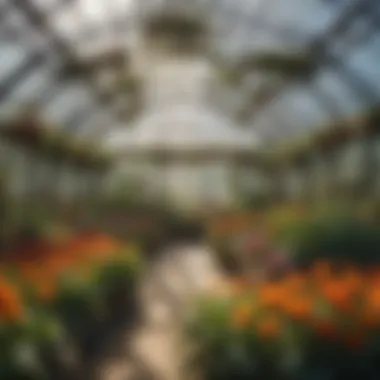

Intro
Hoop tent greenhouses are becoming increasingly popular in agricultural practices. Their shape and structure make them effective for a range of growing conditions. In this article, we will explore the fundamentals of hoop tent greenhouses, including their benefits, design considerations, and practical applications. The goal is to provide valuable insights for both farmers and gardening enthusiasts.
Key Concepts and Terminology
Basic Definitions
A hoop tent greenhouse is a structure, usually made of lightweight materials, that is formed by bending hoops of metal or plastic. These hoops support a covering, typically made of plastic film or shade cloth. They provide a controlled environment for growing plants, allowing for temperature and humidity regulation favorable to plant growth.
Historical Context
The concept of using greenhouses dates back centuries. However, hoop tent greenhouses gained popularity in the late 20th century. They offered a more affordable and easier alternative to traditional glass greenhouses. The simplicity of their design means that many farmers can construct their own without needing specialized skills or tools.
Recent Innovations and Trends
Technological Advancements
In recent years, there have been significant advancements in the materials used for hoop tent greenhouses. For instance, newer UV-resistant films increase durability against sun exposure. Moreover, advancements in ventilation designs have improved air circulation inside these structures, reducing the risk of fungal infections.
Sustainable Practices
Many farmers are now integrating eco-friendly practices when using hoop tent greenhouses. For example, rainwater harvesting is often employed for irrigation. Additionally, the use of organic farming methods within these structures supports sustainable agriculture goals. This combination not only benefits crop yield but also has positive effects on the environment.
Practical Applications and Techniques
Step-by-step Guides
- Selecting a Location: Choose a site with good sunlight exposure, ideally south-facing.
- Gathering Materials: Obtain durable hoops, covering materials, and foundation supplies. Poles or stakes may be needed for anchoring.
- Constructing the Frame: Assemble the hoops into an arch shape and secure them in place.
- Adding the Covering: Stretch and secure the film or cloth over the hoops, ensuring a tight fit to withstand wind.
- Setting Up Ventilation: Install vents or openings for airflow to prevent overheating.
Case Studies
Many farms have successfully implemented hoop tent greenhouses to improve productivity. One notable example is the use of hoop houses in Michigan. By using these structures, local farmers increased their early-season vegetable yields by several weeks, significantly enhancing profitability.
Hoop tent greenhouses provide a cost-effective solution for maximizing crop growth and extending growing seasons.
These applications showcase the potential of hoop tent greenhouses to impact various farming practices positively, making them a worthwhile consideration for any agricultural endeavor.
Understanding Hoop Tent Greenhouses
Hoop tent greenhouses represent a compelling intersection of functionality and accessibility in gardening and agriculture. As climate change continues to affect seasonal patterns and cultivators face increasing pressures from pests and disease, such structures offer a versatile solution for improving crop yields and extending growing seasons. By comprehending the core attributes of hoop tent greenhouses, farmers and enthusiasts can leverage this knowledge for better growing results.
Definition and Purpose
A hoop tent greenhouse is a simple structure typically made from bent pipes forming an arch, covered with transparent materials like plastic or fabric. This design creates a warm and sheltered environment conducive to plant growth. These greenhouses serve multiple purposes. Primarily, they protect crops from extreme weather conditions, pests, and pathogens. Furthermore, they enhance light exposure, boosting photosynthesis, which is crucial for healthy plant development.
“Hoop tent greenhouses can significantly increase the viability and health of crops, making them an essential tool in modern agriculture.”
These greenhouses are not just for commercial applications; they can be highly beneficial for home gardeners as well. Smaller versions allow enthusiasts to cultivate a variety of plants, including vegetables and flowers, throughout the year.
Historical Context
The concept of covered growing spaces is not new. Historical records indicate that early forms of greenhouses date back to ancient Rome, where gardeners utilized structures made of wood and glass. However, the modern hoop tent greenhouse paradigm emerged in the latter half of the 20th century. The introduction of lightweight materials and advanced agricultural strategies popularized these constructions, making them accessible to a broader audience. Farmers began to appreciate the advantages of hoop structures for both cost-effective and efficient gardening.
Today, these greenhouses have evolved, incorporating new technologies and materials. Innovations in environmental control have led to improvements in temperature management and energy efficiency, further enhancing their practicality. The continuous evolution of hoop tent greenhouses underscores their significance in sustainable agriculture and their adaptability to various climates and growing conditions.
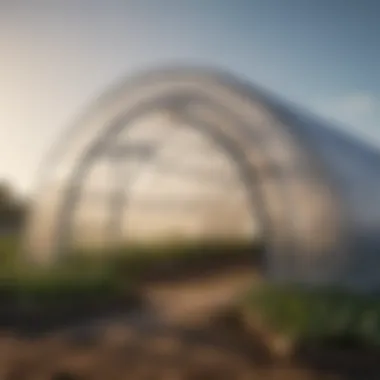
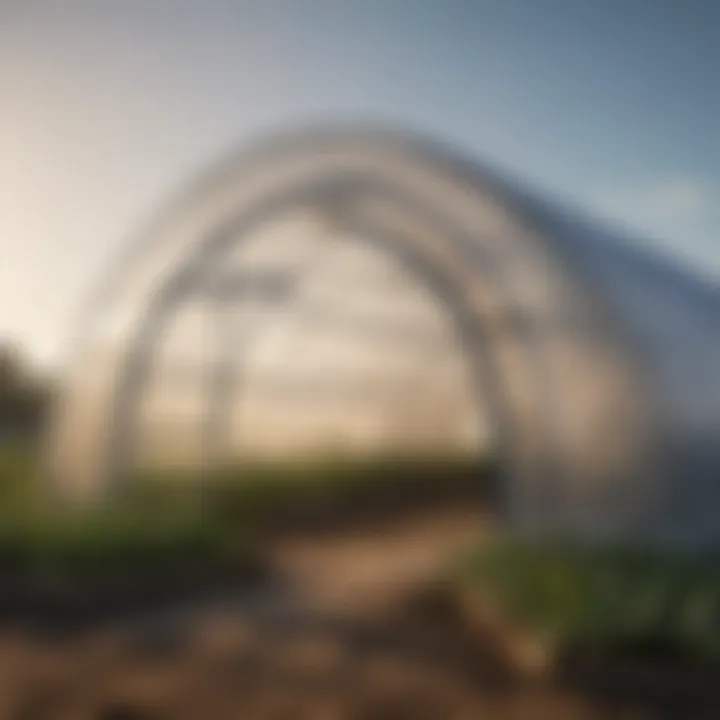
Design and Structure
The design and structure of hoop tent greenhouses play a crucial role in their functionality and effectiveness. This section will cover essential elements such as design principles, material selection, and construction techniques, highlighting why these factors matter in the context of horticulture and agriculture. A well-constructed hoop tent greenhouse not only supports healthy plant growth, but also enhances the resilience and durability needed to withstand external conditions.
Basic Design Principles
When creating a hoop tent greenhouse, understanding basic design principles is essential. The shape of a hoop tent, typically cylindrical, allows for efficient air circulation and maximizes sunlight exposure. This design is instrumental for maintaining a stable internal environment, which is vital for the growth of crops.
Key characteristics of a well-designed hoop tent include adequate height and width to allow easy access for harvesting and tending to plants. Openings for ventilation are also important, as they facilitate airflow and prevent overheating. Moreover, the arrangement of plants inside should consider spacing to promote healthy growth while allowing for ease of movement.
Material Selection
Choosing the right materials is fundamental for constructing a hoop tent greenhouse. Three main components are critical: frames, covers, and fasteners.
Frames
The frame serves as the primary support structure. Often made from galvanized steel or aluminum, these materials are favored due to their strength and resistance to rust. The key characteristic of frames is their ability to endure varying weather conditions without compromising stability.
A unique feature of metal frames is their longevity. They can last for many years with proper maintenance, making them a beneficial choice. However, it's important to ensure that the frame's weight is manageable during construction and installation.
Covers
Covers play a vital role in insulating the greenhouse while allowing light penetration. Common materials for covers include polyethylene, polycarbonate, and shade cloth. One key advantage of polyethylene is its cost-effectiveness and adequate light transmission, which supports plant photosynthesis effectively.
Additionally, polycarbonate provides greater durability and UV protection. However, high-quality options can be more expensive, which might be a drawback for some growers. Overall, the choice of cover should depend on specific needs, including budget and plant types being cultivated.
Fasteners
Fasteners secure different components of the greenhouse together, ensuring structural integrity. Common fasteners include bolts, screws, and clamps. A key characteristic of fasteners is their ability to withstand both wind and rain, securing the greenhouse against potential damages.
Fasteners made from stainless steel are particularly popular due to their corrosion resistance, adding durability to the structure. However, fasteners may require periodic checks to ensure they are tight and effective, representing the maintenance aspect of the greenhouse setup.
Construction Techniques
Proper construction techniques are the final piece in building a successful hoop tent greenhouse. Planning the construction site is vital, considering factors like sunlight exposure, drainage, and accessibility.
During construction, start with a sturdy frame, ensuring all connections are secure. It is essential to install the cover tightly and evenly to prevent sagging or wind-induced damage. Additionally, reinforcing areas prone to stress or movement can improve durability.
Advantages of Hoop Tent Greenhouses
The advantages of hoop tent greenhouses are significant to gardeners, farmers, and anyone interested in improving agricultural practices. These structures provide a controlled environment that benefits plants in various ways. The essentials of such advantages are reflected in their ability to enhance plant health, crop yield, and sustainability.
Temperature Regulation
One crucial advantage of hoop tent greenhouses is temperature regulation. This feature is essential for successful plant growth. The design of the hoop tent allows sunlight to enter and warm the interior. This warmth helps keep temperatures stable during cooler nights.
Moreover, the controlled environment can protect plants from extreme weather conditions. For example, in chilly climates, a hoop tent can create a microclimate, reducing the risk of frost. Plants thrive when they have consistent temperatures. This stability encourages healthy growth patterns and leads to better fruit and vegetable production. The ability to regulate temperature is vital for extending the growing season, allowing crops to be planted earlier and harvested later than in traditional gardening methods.
"The environment within a hoop tent greenhouse can be crucial for fostering optimal plant conditions."
Pest Control
Another advantage is improved pest control. Hoop tents serve as a barrier against many pests, reducing the need for chemical pesticides. The physical structure helps keep unwanted insects and animals at bay. This feature is especially useful for organic farmers who prefer natural methods.
Integrated pest management becomes more effective within these greenhouses. Beneficial insects, such as ladybugs, can thrive in this environment, controlling populations of harmful pests. Furthermore, controlling the environmental conditions provides unpredictable weather that reduces pest survivability. By minimizing pest exposure, hoop tent greenhouses contribute to healthier crops and less reliance on synthetic solutions.
Extended Growing Season
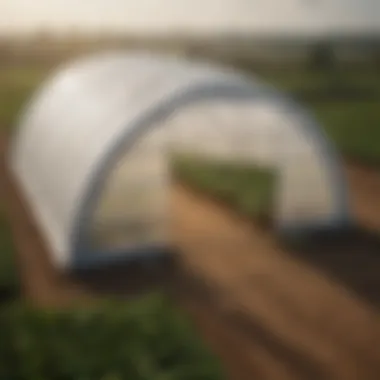
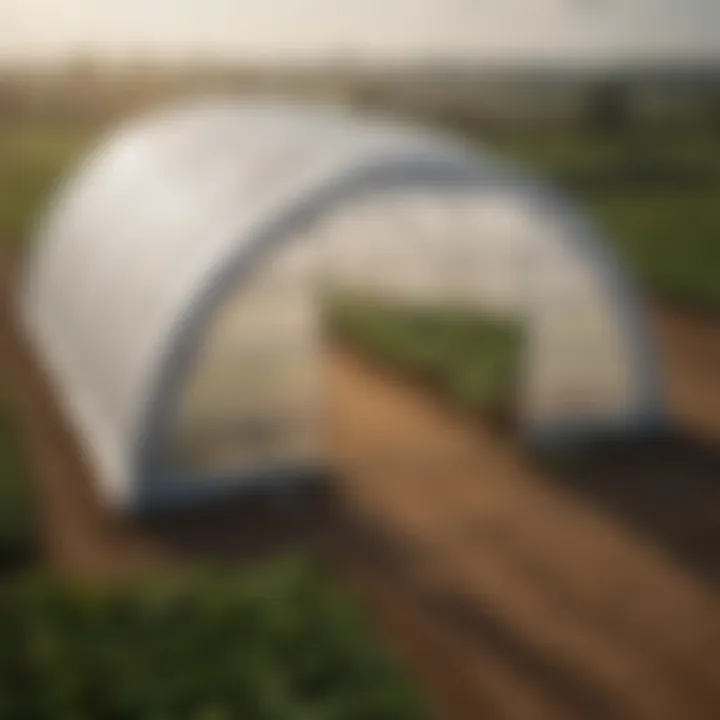
Extending the growing season is perhaps one of the most appealing benefits of using hoop tent greenhouses. These structures allow for earlier planting in spring and later harvesting in fall. The protection from harsh weather promotes rapid plant growth, leading to higher yields.
Additionally, with climate change impacting growing seasons across various regions, hoop tents offer a practical solution. Farmers can adapt to unpredictable weather patterns. The extended season can significantly increase the profitability of crops by allowing multiple harvests within a year.
Challenges in Setup and Maintenance
Setting up and maintaining a hoop tent greenhouse involves various challenges that can impact its effectiveness. Addressing these challenges is important for ensuring the longevity and functionality of the greenhouse. Understanding site selection, maintenance requirements, and potential obstacles can enhance the effectiveness of hoop tent greenhouses.
Site Selection
Choosing the right location for a hoop tent greenhouse is crucial in maximizing its benefits. Factors such as sunlight exposure, wind patterns, and soil drainage must be considered. Sitings with direct sunlight will optimize plant growth, while avoiding shaded areas ensures adequate warmth. Also, wind can affect the structure's stability. Thus, selecting a sheltered spot can reduce wear and tear on materials.
Maintenance Considerations
Regular maintenance ensures that hoop tent greenhouses function optimally. Attention to specific aspects helps prevent major repairs and extend the lifespan of the greenhouse.
Repairing Damage
Repairing damage promptly is essential for maintaining the integrity of a hoop tent greenhouse. This includes fixing tears in the covering or addressing structural issues. Regular checks can help identify wear before it becomes a larger problem. A key characteristic of damage repair is the use of robust materials, such as duct tape or fabric patches. Damage repair is a beneficial choice because it prevents larger disruptions in plant health from occurring. Conducting repairs in a timely manner helps minimize production loss.
Cleaning
Cleaning the greenhouse plays an important role in maintaining a healthy growing environment. Dirt and plant residues can harbor pests and diseases that may threaten plant life. A regular cleaning schedule helps to eliminate these risks. Using mild soap and water is a common practice to ensure safety for the plants. The unique feature of cleaning is that it can be done efficiently, creating a safer environment. However, excessive cleaning can disturb the ecosystem and should be done thoughtfully.
Weather Resistance
Weather resistance is a critical consideration for hoop tent greenhouses, especially in regions prone to harsh weather conditions. Reinforcing frames and using durable covers can enhance resilience against rain, snow, or wind damage. The key characteristic of weather resistance is its ability to protect the greenhouse even under challenging circumstances. Implementing weather-resistant features is beneficial, ensuring that crops remain healthy during adverse weather conditions. Nevertheless, the challenge lies in continually assessing the structure's condition after weather events.
Environmental Impact
Understanding the environmental impact of hoop tent greenhouses is critical. These structures can significantly contribute to sustainable gardening and agriculture practices. As climate change poses new challenges to food production, hoop tents offer innovative solutions that align with eco-friendly methods. Here, the focus will be on sustainability and the carbon footprint associated with these greenhouses.
Sustainability Aspects
Hoop tent greenhouses are inherently sustainable for several reasons. First, they allow for efficient use of resources. By extending the growing season, they help reduce food miles since local producers can grow crops year-round, minimizing transport emissions.
The design and materials used are often recyclable or biodegradable. For example, polyethylene covers are common due to their light weight and durability, but they can also be replaced or recycled at the end of their life, reducing landfill waste. Furthermore, these structures generally require less energy than traditional greenhouses, aligning well with sustainability objectives.
Considerations for improving sustainability include:
- Water Efficiency: Hoop tents can integrate rainwater harvesting systems, reducing reliance on municipal water.
- Ecosystem Benefit: Properly designed, they can support local biodiversity, providing habitats for beneficial insects like pollinators.
- Soil Health: Growing under hoop tents encourages practices such as composting, which improves soil quality and reduces the need for chemical fertilizers.
Carbon Footprint
When analyzing the carbon footprint of hoop tent greenhouses, a few factors are key. The minimal use of fossil fuels in their construction and operation stands out. Most hoop tents can be assembled using simple tools without heavy machinery. Their lightweight materials also mean lower emissions during transport.
Moreover, hoop tents facilitate practices like organic farming, which leverages natural inputs and reduces greenhouse gas emissions associated with synthetic fertilizers and pesticides.
Here's how hoop tents help minimize carbon footprints:
- Local Production: Growing food locally reduces emissions related to transport.
- Less Heating Needed: Their structure allows for warmer temperatures, reducing energy input for heating, especially in colder months.
- Soil Sequestration: Healthier soils capture more carbon, and hoop tents often encourage practices that enhance soil health.
In summary, hoop tent greenhouses not only provide an immediate benefit in terms of crop yield and health but also contribute to a more sustainable agricultural future. The environmental impact they carry is increasingly recognized as a vital aspect of modern farming.
Integrating Hoop Tents in Sustainable Practices
Integrating hoop tents into sustainable agriculture practices offers a way to enhance crop production while minimizing environmental impact. These structures provide a controlled environment, which is crucial for optimizing growth conditions. Their design facilitates temperature regulation, moisture control, and increased light exposure. This adaptability can lead to higher yields and healthier plants.
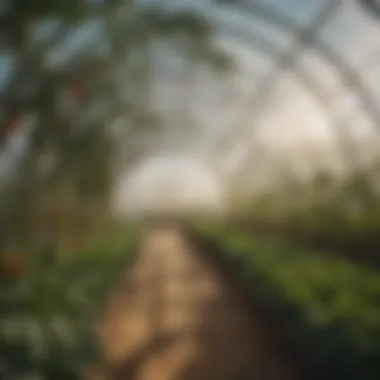

Organic Farming Techniques
Organic farming is an essential component of sustainable practices. By integrating hoop tents, farmers can better control growing conditions while adhering to organic principles. This allows them to grow in an environment that reduces the reliance on synthetic products.
- Soil Management: Hoop tents enable farmers to implement crop rotation and cover cropping effectively. This practice boosts soil health, prevents erosion, and enhances nutrient availability.
- Pest Management: Natural pest control methods can be optimized within hoop tents. Techniques such as introducing beneficial insects or using organic pesticides help maintain ecological balance.
- Water Conservation: By cultivating plants in hoop tents, farmers can use drip irrigation systems more efficiently, thus reducing water usage.
These factors contribute to a sustainable approach, preserving the integrity of the ecosystem while maintaining productive farming.
Companion Planting
Companion planting within hoop tents represents another method to maximize sustainability. This practice involves growing different plants in close proximity to benefit one another. Benefits of companion planting include:
- Natural Pest Deterrents: Certain plants can repel pests that threaten nearby crops. For example, marigolds are known to deter nematodes and other harmful insects when planted alongside tomatoes.
- Nutrient Enhancement: Some plants improve soil fertility, which helps others thrive. For instance, legumes fix nitrogen in the soil, benefiting neighboring plants like corn that require high nitrogen levels.
- Space Optimization: In a limited area, companion planting maximizes yield. When plants grow together, they can utilize light, nutrients, and space more effectively.
Implementing these practices contributes not only to enhanced crop yields but also to the health of the ecosystem. This symbiosis is vital for moving towards a more sustainable method of food production.
"The incorporation of hoop tents with sustainable practices, such as organic farming and companion planting, is a step towards a greener future in agriculture."
Case Studies and Practical Applications
Understanding the practical applications of hoop tent greenhouses serves as a vital component in the discourse about their benefits. These real-world examples not only illustrate the effectiveness of such structures but also provide insights into their adaptability across various settings. Case studies can showcase diverse results, emphasizing how these greenhouses meet unique agricultural challenges and enhance productivity.
By examining specific instances, readers can grasp the tangible advantages of hoop tent greenhouses. Moreover, these practical applications highlight considerations such as localized environmental factors, crop choices, and management strategies, making the subject more relatable and actionable for farmers and gardening enthusiasts.
Home Gardening
In home gardening, hoop tent greenhouses offer a flexible solution for individuals seeking to optimize their growing conditions. These can be ideal for small spaces, helping enthusiasts to extend their growing seasons.
- Temperature Control: The structure effectively maintains warmth during cooler months, fostering healthier plants. Home gardeners can cultivate a variety of vegetables, fruits, and flowers that would otherwise perish in colder climates.
- Space Efficiency: For those with limited outdoor space, a hoop tent can be set up in a backyard or even on balconies. Its design allows for vertical gardening techniques, thus maximizing yields in confined areas.
- Pesticide Reduction: By providing a controlled environment, these greenhouses minimize pest presence, reducing the need for chemical treatments. This known benefit aligns with modern gardening practices that emphasize organic methods.
Commercial Agriculture
In the realm of commercial agriculture, hoop tent greenhouses provide scalability and economic benefits. Here is how they adapt to larger farming operations:
- Cost-Effectiveness: Compared to traditional greenhouses, hoop tents are less expensive to construct and maintain, making them attractive to farmers. This affordability allows for quick implementation and operational adjustments based on market demands.
- Crop Diversity: Farmers can experiment with different crops throughout the year. This adaptability can lead to increased market offerings and reduced reliance on seasonal cycles.
- Irrigation Efficiency: Many commercial hoop greenhouses employ advanced irrigation systems, optimizing water usage and ensuring consistent moisture for crops. Efficient water management contributes to sustainability goals and improves overall output.
- Case Example: A recent study showed that adopting hoop tent greenhouses resulted in a 30% increase in crop yield for a small farm in California. Adapting this technology allowed the farmer to diversify produce while reducing resource consumption.
"Hoop tent greenhouses not only help in enhancing yield but also contribute to sustainable farming practices, making them ideal for both amateur gardeners and professional farmers."
The exploration of case studies in home gardening and commercial agriculture establishes the essential role of hoop tent greenhouses. The evidence of their success across various applications underscores their significance in modern horticulture, presenting a case for their wider adoption.
Future Directions for Hoop Tent Greenhouses
As the agricultural landscape evolves, the significance of hoop tent greenhouses becomes apparent. Emphasizing their future directions captures not only the innovations emerging in design but also the critical research guiding sustainable practices. Farmers and enthusiasts alike must stay apprised of these developments, as they present opportunities for improved efficiency and increased crop yields.
Innovations in Design
Innovative designs are reshaping the hoop tent greenhouse concept. One critical aspect involves the integration of smart technology. Sensors can now monitor various environmental factors, such as temperature, humidity, and soil moisture levels. Data gathered improves decision-making and ensures optimal conditions for plant growth.
Another innovation is the use of modular designs. This approach allows for flexibility in construction and expansion. Farmers can tailor their greenhouses to fit the specific needs of their crops without extensive renovations. Lightweight materials like ethanol-based composites are also gaining traction. They offer durability while reducing the overall weight, making installations more accessible.
Furthermore, innovative ventilation systems introduce energy efficiency. Solutions like passive solar design and climate control systems harness natural resources, reducing reliance on external energy.
Research and Development
The landscape of hoop tent greenhouses is also undergoing significant transformation due to ongoing research and development. Institutions are prioritizing studies that analyze nutrient management specific to enclosed environments. Findings reveal how to optimize nutrient delivery, minimizing waste while maximizing plant health.
In parallel, researchers are focusing on the effects of climate change on hoop tent structures. Adaptation strategies focus on enhancing resilience against extreme weather conditions. Such advancements are vital as unpredictable climate patterns place additional strain on agricultural practices.
Collaboration between universities and agricultural associations fosters further innovation. By sharing findings and insights, these organizations push the boundaries of technology and sustainability. Additionally, funding initiatives aimed at experimenting with new materials and construction techniques are emerging. This support plays an essential role in energizing the future of hoop tent greenhouses.
The future of hoop tent greenhouses lies in creativity and sustainability. Advances in design and research are integral to meeting the challenges of modern agriculture, producing healthier crops while respecting the environment.
In summary, the future directions for hoop tent greenhouses hold significant promise. As farmers adapt to innovations in design and embrace research findings, they enhance their agricultural practices. The ongoing commitment to optimizing these structures will ultimately lead to healthier crops and a more sustainable agricultural future.















